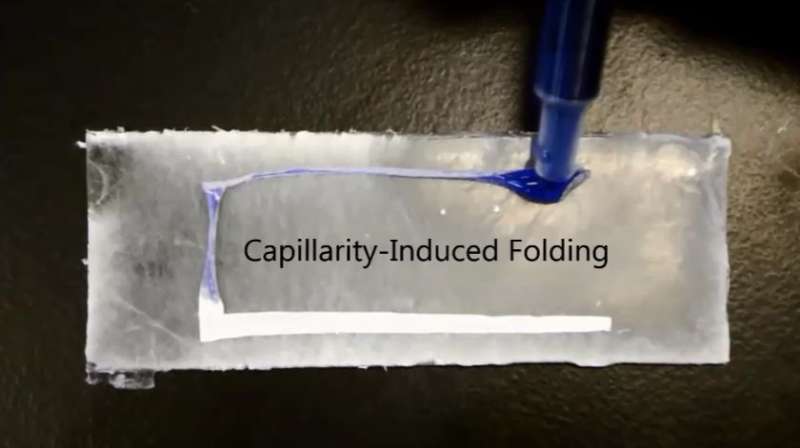June 27, 2016 report
A man-made material that mimics the curling of the mimosa leaflet

(Phys.org)—A combined team of researchers from the Australian National University and City University of Hong Kong has created a material that is capable of mimicking the action of a mimosa leaflet when it is touched. In their paper published in the journal Science Advances, the team describes their material and how it reacts when a drop of liquid is deposited onto its surface.
As the researchers note, nature is filled with examples of living systems that react to stimuli by engaging in self-organization behaviors. One such example is the fern-like mimosa plant, it has multiple leaflets along individual twigs that are each independently sensitive to touch—such stimuli (such as children over the generations having some fun with their friends) causes the leaflet to curl up into a hollow tube shape resembling a very small straw. Developing materials with similar characteristics is highly desirable because it allows for creating unique products, such as very low power sensors.
In this new effort, the researchers created the new material by fashioning stacks of multi-function layers of a Janus nanoparticle based material (offering opposite hydrophilic-hydrophobic properties) to a bottom layer made of polyvinyl chloride microfibers. The result was a thin length of flat white material with a larger round formation at one end. When a liquid was dropped onto the round formation, the liquid was pushed, through self-action, by the material all the way to the other end—as it was pushed, the material curled from one end to the other, resulting in what looked like an ordinary straw. The researchers report that the action was fast, taking just 33 milliseconds to get started. They note also that the self-action was reversible as well—as the material dried, it flattened.
In addition to providing a roadmap for the development of a new class of self-organizing materials, the team believes their material could be used in a wide variety of applications, ranging from sensors built into clothes (which could self-activate when exposed to sweat) to sensors made for responding to other bodily fluids. It might even prove suitable for harvesting water from fog or for creating micro-robotic devices programmed by shape.
More information: W. S. Y. Wong et al. Mimosa Origami: A nanostructure-enabled directional self-organization regime of materials, Science Advances (2016). DOI: 10.1126/sciadv.1600417
Abstract
One of the innate fundamentals of living systems is their ability to respond toward distinct stimuli by various self-organization behaviors. Despite extensive progress, the engineering of spontaneous motion in man-made inorganic materials still lacks the directionality and scale observed in nature. We report the directional self-organization of soft materials into three-dimensional geometries by the rapid propagation of a folding stimulus along a predetermined path. We engineer a unique Janus bilayer architecture with superior chemical and mechanical properties that enables the efficient transformation of surface energy into directional kinetic and elastic energies. This Janus bilayer can respond to pinpoint water stimuli by a rapid, several-centimeters-long self-assembly that is reminiscent of the Mimosa pudica's leaflet folding. The Janus bilayers also shuttle water at flow rates up to two orders of magnitude higher than traditional wicking-based devices, reaching velocities of 8 cm/s and flow rates of 4.7 μl/s. This self-organization regime enables the ease of fabricating curved, bent, and split flexible channels with lengths greater than 10 cm, demonstrating immense potential for microfluidics, biosensors, and water purification applications.
Journal information: Science Advances
© 2016 Phys.org





















